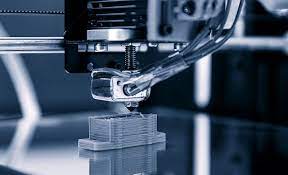Unlike traditional manufacturing methods, metal rapid prototyping can reduce production time from years and months to days. It also eliminates the need for injection molding, machining, and forming.
Meld Manufacturing’s machines use force and stirring action rather than heat to bind layers of metal together. It’s called friction-stir deposition.
Rapid prototyping
Rapid prototyping with 3D metal printers allows manufacturers to create scaled models of their products before committing resources to mass production. This can reduce development time from years and months to weeks and days. It also allows organizations to make improvements to their designs before they go into production, resulting in better product quality and lower costs.
Designing for 3D printing
A 3D printing process transforms digital designs into solid metal objects in days or weeks, compared to months and years for traditional manufacturing. This technology helps reduce time to market by allowing companies to rapidly produce prototypes and refine their product before going into mass production.
Engineers can now test the feel, functionality and durability of a design before moving to the next stage. This means that the design can be improved in real-world testing, resulting in a more effective product. In addition, rapid prototyping reduces costs by reducing the need for secondary processing.
The first step in designing for metal 3D printers is to create a CAD model of the part. This file is then converted into a STL format, which can be understood by a metal printer. Once the CAD model is ready for printing, the machine spreads a layer of metal powder over the surface and heats it with a laser beam. The melted powder is then fused together to form the desired object.
The most common metal materials for metal 3D printing are aluminium and steel. Aluminium offers good resistance, while steel provides strength and durability. Another option is to use a liquid metal printer, which uses a chemical bath. This method is fast and can create a complex shape without the need for supports. Other metal additive manufacturing methods include cold spraying, which involves projecting powders using a nozzle without applying heat, and direct energy deposition (DED), which uses a CLAD laser to build up layers of metal.
Selective laser melting (SLM)
SLM is a 3D printing technology that uses a laser beam to melt and fuse various metallic powders together to build up a metal part layer by layer. The laser beam is focused through carefully designed scanner optics to selectively melt parts of the powder. This allows the fabrication of complex-shaped geometries that are not feasible with other AM processes. It also eliminates the need for support structures, which can significantly reduce the production time and warping of the printed part.
The SLM process is extremely precise, with tolerances of +/- 0.005 in. In addition, it can produce very high-density parts with good mechanical properties, which makes it ideal for medical applications. The process is also very energy efficient, allowing the production of large parts with small footprints.
For better surface finish, SLS parts can be bead blasted after the build to remove loose powder and create a smooth matte finish. However, the process cannot print very fine text, as the laser beam has a maximum feature size of about 0.030 in. As a result, most SLS parts are readable with a magnifying glass. This can be overcome by using inset text, but this limits the number of available characters to six.
Laser oxidation (LOM)
Laser oxidation (LOM) is an additive manufacturing process that produces metal prototypes quickly and cost-effectively. The technique involves a laser beam that heats the surface of the material. This causes the formation of a thin oxide layer. This creates a permanent mark that is much more durable than engraving or other surface altering processes. This method is also environmentally friendly, as it doesn’t produce any waste.
LOM is an inexpensive method of creating a prototype and can be used for both plastics and metals. It is a great alternative to traditional metal fabrication methods, which require expensive tools and can be difficult to operate. It is an ideal option for prototyping parts that are complex and have a lot of curves or shapes.
The process begins by scanning the object with a 3D scanner and then creating a CAD model of it. The XJet is the latest addition to the world of metal 3D printing, and it has the potential to revolutionize the industry. This new technology uses an inkjet-like system to jet nanoparticle inks and a support material that bond the metal powders together to build up layers of an object.
Direct energy deposition (DED)
DED is a form of additive manufacturing that uses lasers or electron beams to deposit melted material on a workpiece. The process is similar to powder bed fusion, but with the added advantage of being able to build complex geometries and structures. This makes it ideal for applications like aerospace and automotive. DED can also print complex metal parts with a high degree of accuracy.
The DED process is capable of printing a wide variety of materials, including polymers and ceramics. However, when it comes to metals, the process is most often used with metal powder. There are two main types of DED systems: those that use a wire filament and those that use a powder feed. Both have their advantages and disadvantages. The most important factor in deciding which system to choose is the type of material you expect to print. This will dictate the size of the part you need and the precision required to print it.
DED is a great alternative to traditional manufacturing, which requires injection molding, forming, welding, and machining to create an object. The DED process eliminates the need for these steps, which can reduce production times from years and months to weeks and days. This can save time and money, as well as reduce the number of prototypes needed for testing and evaluation.
Thanks for visiting readniewblog

